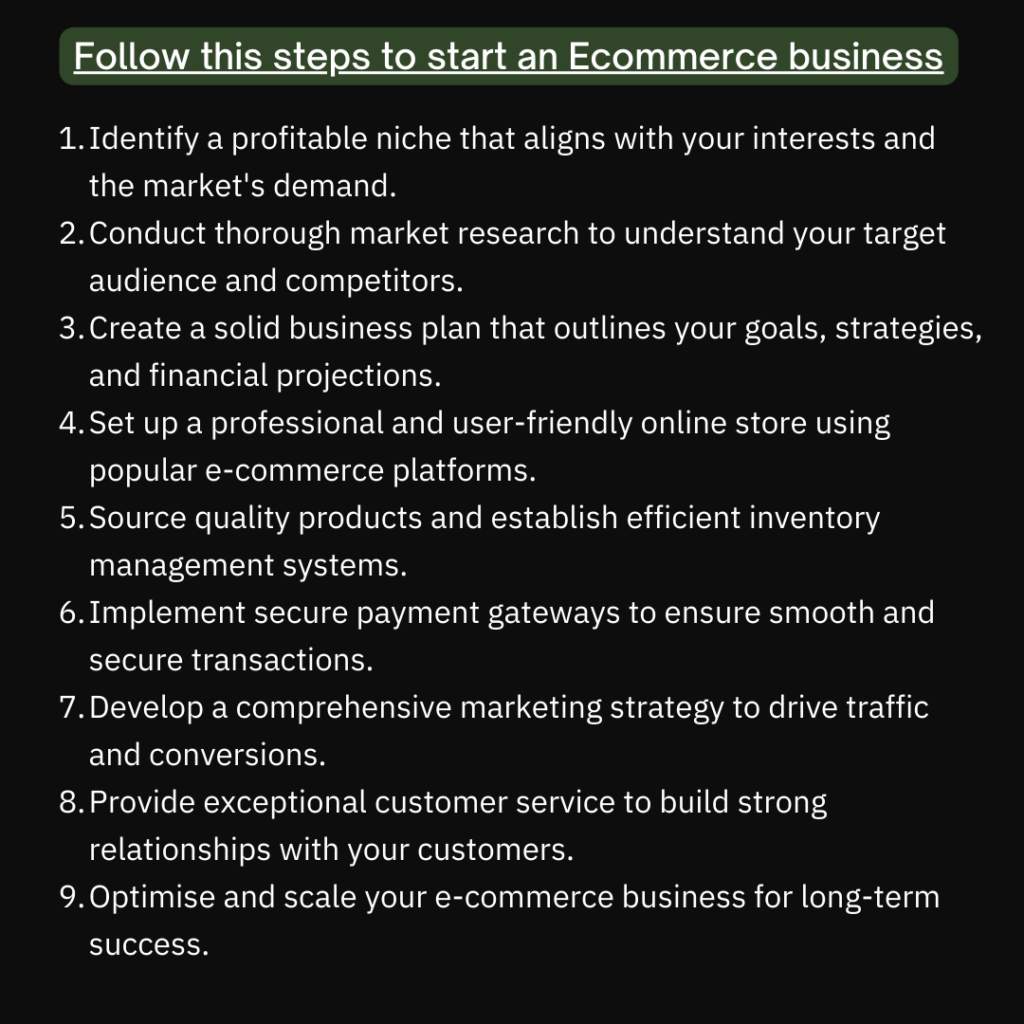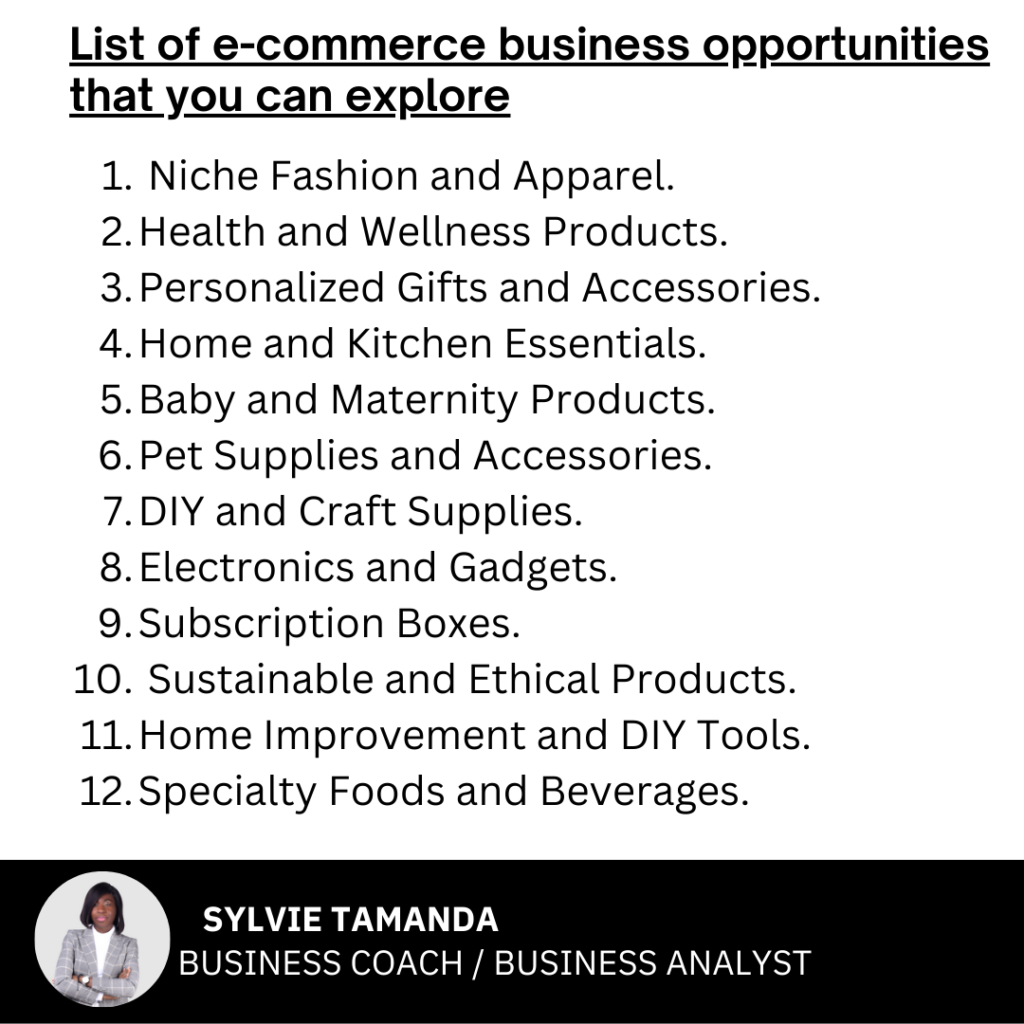As the world struggles with the painful rise in prices due to inflation, creating new sources of income has never been more appealing for people who want to stop robbing Peter to pay Paul and experience a more comfortable way of life where they don’t have to keep awake through the night, thinking about their next bill to pay and where the money will come from.
This is why, over the next 5 days, I will be sharing in detail how to start one of the profitable business ideas that I have identified.
This series is not a waste of my time, but it is a gift to those who want to stop complaining, roll up their sleeves, and get their hands dirty. It is for people who are eager to take their own financial destiny into their own hands and make things happen for them and their families!
So, let me ask you this: Are you ready to embark on an exciting entrepreneurial journey in the world of e-commerce?
If you are, here is a step-by-step guide to help you navigate the process of starting your very own e-commerce business.
E-commerce has revolutionised the way we shop and conduct business, and it offers immense opportunities for aspiring entrepreneurs like you. Whether you have a passion for fashion, unique handmade products, or specialised niche items, the online marketplace is your gateway to success.
This guide will take you through the essential steps required to launch and grow your e-commerce business. From identifying your niche to setting up your online store, sourcing products, and developing a marketing strategy, it covers it all.
I hope this encourages you and gives you the push you need to unleash your entrepreneurial spirit and bring your e-commerce dreams to life!

Starting an e-commerce business may seem daunting, but with this step-by-step guidance, you’ll have the knowledge and tools to confidently navigate the process. Whether you’re a seasoned entrepreneur or just starting out, this guide is designed to support you every step of the way. So let’s dive in!
Step 1: Identify Your Niche

Here’s a list of e-commerce business opportunities that you can explore:
- Niche Fashion and Apparel: Focus on a specific fashion niche, such as sustainable clothing, activewear, or plus-size fashion. Cater to specific customer segments and provide unique and trendy clothing options.
- Health and Wellness Products: With the increasing demand for health-conscious products, consider selling items like organic supplements, fitness equipment, natural skincare products, or eco-friendly home goods.
- Personalized Gifts and Accessories: Offer customizable products like engraved jewelry, personalized stationery, custom-made artwork, or personalized home decor items. Tap into the market for unique and meaningful gifts.
- Home and Kitchen Essentials: Provide a wide range of home and kitchen products, such as innovative gadgets, eco-friendly utensils, stylish home decor, or specialty cookware. Target homeowners and cooking enthusiasts.
- Baby and Maternity Products: Tap into the baby and parenting market by selling baby clothing, toys, nursery decor, breastfeeding essentials, or maternity wear. Focus on high-quality, safe, and sustainable products.
- Pet Supplies and Accessories: Cater to pet owners with a variety of pet supplies, including pet food, grooming products, toys, and fashionable accessories. Explore specialized niches like organic pet products or luxury pet items.
- DIY and Craft Supplies: Serve the creative community by offering craft supplies, DIY kits, art materials, and hobby-specific products. Target artists, crafters, and DIY enthusiasts.
- Electronics and Gadgets: Enter the tech market by selling electronics, gadgets, smart home devices, or innovative tech accessories. Stay up to date with the latest trends and focus on quality products.
- Subscription Boxes: Curate subscription boxes that cater to specific interests or themes, such as beauty, food, fitness, or lifestyle. Provide a monthly or quarterly delivery of curated products to subscribers.
- Sustainable and Ethical Products: Embrace the growing demand for eco-friendly and socially responsible products. Offer environmentally friendly alternatives like sustainable clothing, zero-waste products, or ethically sourced goods.
- Home Improvement and DIY Tools: Target homeowners and DIY enthusiasts by offering a range of home improvement tools, equipment, and supplies. Provide detailed product information and guides to assist customers in their projects.
- Specialty Foods and Beverages: Capitalize on the gourmet food and beverage market by offering specialty or artisanal products. This can include organic snacks, international cuisine ingredients, or craft beverages.
Step 2: Conduct Market Research

Step 3: Create a Business Plan

Step 4: Set Up Your Online Store
Here is a bullet list of suitable e-commerce platforms commonly used for building online stores:
- Shopify: A widely popular and user-friendly e-commerce platform with robust features and customizable templates. It offers easy setup, a wide range of integrations, and scalable options for businesses of all sizes.
- WooCommerce: An open-source e-commerce plugin built on WordPress. WooCommerce provides flexibility, extensive customization options, and seamless integration with WordPress websites.
- Magento: A powerful and feature-rich e-commerce platform suitable for large-scale enterprises. It offers advanced functionalities, high scalability, and extensive customization options.
- BigCommerce: A comprehensive e-commerce platform that caters to businesses of all sizes. It provides a range of built-in features, mobile responsiveness, and easy integration with popular payment gateways.
- Wix: Known for its user-friendly interface, Wix offers an all-in-one platform that includes website building and e-commerce functionalities. It provides drag-and-drop design options, customizable templates, and secure online transactions.
- Squarespace: A visually appealing platform that combines website building and e-commerce capabilities. Squarespace offers beautiful templates, intuitive design tools, and built-in SEO features.
- PrestaShop: An open-source e-commerce platform that is highly customizable and suitable for small to medium-sized businesses. PrestaShop offers a wide range of modules, multi-language support, and a thriving community.
- Volusion: A user-friendly e-commerce platform that caters to small and medium-sized businesses. It provides a comprehensive set of features, easy-to-use design tools, and built-in marketing functionalities.
- OpenCart: An open-source e-commerce platform known for its simplicity and ease of use. OpenCart offers a lightweight solution, multi-store capabilities, and a vast library of extensions and themes.
- Salesforce Commerce Cloud: A robust enterprise-level e-commerce platform that offers scalability, omnichannel capabilities, and advanced marketing tools. It provides a comprehensive solution for large-scale businesses.
When choosing an e-commerce platform, consider factors such as your business size, budget, desired features, customization options, scalability, and ease of use. Evaluate the platform’s compatibility with your specific needs and select the one that best aligns with your business goals and requirements.
Step 5: Source Products and Inventory Management
Step 6: Set Up Secure Payment Gateways
Here’s a list of payment gateways to consider
- PayPal: PayPal is a widely recognized and trusted payment gateway that enables secure online transactions. It supports payments in various currencies and offers seamless integration with e-commerce platforms.
- Stripe: Stripe is a popular payment gateway known for its developer-friendly features. It offers customizable payment solutions, supports recurring billing, and provides a seamless checkout experience.
- Authorize.Net: Authorize.Net is a reliable payment gateway that provides a range of payment options, including credit cards, e-checks, and digital payments. It offers fraud prevention tools, recurring billing, and robust security features.
- Square: Square is known for its user-friendly interface and extensive features. It allows businesses to accept payments online, in-store, and through mobile devices. Square offers quick setup, competitive fees, and seamless integration options.
- Braintree: Braintree, a PayPal service, offers a robust payment gateway with global reach. It supports multiple payment methods, including credit cards, PayPal, and digital wallets. Braintree provides advanced fraud protection and supports recurring billing.
- 2Checkout: 2Checkout is a global payment gateway that supports multiple payment methods and currencies. It offers a simple integration process, customizable checkout pages, and various fraud prevention tools.
- PayU: PayU is a leading payment gateway provider, primarily focused on emerging markets. It supports multiple payment options, local payment methods, and offers a seamless checkout experience.
- Worldpay: Worldpay is a well-established payment gateway with a global presence. It supports multiple currencies and payment methods, including credit cards and alternative payment options. Worldpay provides robust security measures and advanced fraud detection.
- Payza: Payza offers a versatile payment gateway with support for multiple currencies and payment methods. It allows businesses to accept payments globally, and offers features such as recurring billing and secure checkout options.
- Razorpay: Razorpay is a popular payment gateway in India, catering to the needs of small and medium-sized businesses. It supports multiple payment methods, provides quick integration, and offers advanced security features.
When selecting a payment gateway for your e-commerce site, consider factors such as transaction fees, setup process, integration options, supported currencies, and security measures. Choose a payment gateway that aligns with your business requirements and provides a seamless checkout experience for your customers.
Step 7: Develop a Marketing Strategy
Step 8: Provide Excellent Customer service.
Step 9: Optimise and Scale
Remember, starting an e-commerce business requires dedication, ongoing learning, and adaptability. Tailor your products, branding, and marketing efforts to cater to the needs and preferences of your potential customers. Another important thing to do is to remain abreast of industry trends, customer demands, and technological advancements in order to be competitive in the ever-evolving e-commerce landscape. With dedication, innovation, and a customer-centric approach, you can establish a successful e-commerce business in any of these areas.